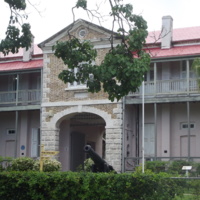
Barbados Museum and Historical Society
The Barbados Museum and Historical Society was founded in 1933. It is a not-for-profit, non-governmental organisation which aims to collect, preserve and interpret Barbadian heritage for its communities. Housed in a former prison, the museum now holds a collection of around half a million objects, dating from prehistory to today, as well as a significant archive.
The museum's permanent galleries explore the history of Barbados and its people through a range of different themes, including social, natural and military history. Colonialism and slavery feature as key themes in several of these galleries. In the Jubilee Gallery, which contains items relating to social history, the exhibition narrative charts four thousand years of Barbadian history. This includes the development of Barbados into a plantation society, life for the enslaved on those plantations and their lives post-emancipation. The Charles A. Robertson African Gallery also reflects on the legacies of slavery with regards to the African diaspora and its heritage within the Caribbean. Here the focus is on the processes of the slave trade, particularly the forced movement of people to the island. Objects in this exhibition reflect different African kingdoms, traditional customs and the diversity of African people.
In addition to its permanent exhibitions the museum also offers a range of learning opportunities relating to the history of slavery in the area. From educational island tours, to school visits and a programme of public events, the museum caters for a wide range of audiences.
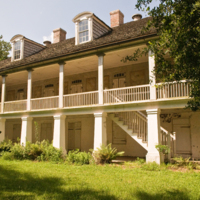
The Whitney Plantation
Widely claimed to be the first museum in America to solely address slavery, the Whitney Plantation is a plantation estate, museum and memorial outside New Orleans, on Louisiana's famed River Road. During the eighteenth and nineteenth centuries, the plantation was home to the Haydel family, and their enslaved workers. The site was bought in 2000 by a retired lawyer, John Cummings, who funded the renovation and redevelopment of the site, which opened to the public as a museum in 2014. On arrival, visitors must join a guided tour to see the majority of the site, but the museum is open to all.
On the property visitors will find a range of exhibits, including the Mansion House, slave quarters, a blacksmith's shop and a Baptist church. There is also a 'Wall of Honour' which features the names of all those enslaved at the plantation, as taken from the site's archives. In addition, there is a sculpture installation created by American artist Woodrow Nash called 'The Children of Whitney,' that seeks to remind visitors that slavery affected children as well as adults.
The site houses a significant collection of artefacts too. These range from plantation tools and house furniture. There is even the largest collection of sugar kettles in the whole of Louisiana. Much of this collection has been purchased at auctions around the USA, in a bid to redisplay the site as it was during the antebellum period. There are three archaeological sites which also contribute collections of material linked to the lives of the enslaved themselves. All of this provides visitors with a unique perspective of plantation life, and helps to break down the ignorance still surrounding histories of American enslavement.
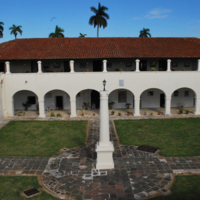
Museo Nacional Ruta del Esclavo
The Museo Nacional Ruta del Esclavo (Slave Route National Museum) is housed in San Severino Castle, in the Matanzas district of Cuba. It opened in 2009, as the product of UNESCO's Slave Route project. Off the beaten tourist track, the museum in the seventeenth-century castle receives few visitors.
The museum itself houses an important exhibition, aimed at showcasing the horrors of the Transatlantic Slave Trade in order to prevent the like ever happening again. The museum has four exhibition rooms with photographs, objects and archaeological items accompanied by interpretive text. These rooms address the origins of slavery, the plantation systems, abolition and emancipation, and the ongoing legacies affecting people of African heritage around the world.
After being selected by UNESCO to house interpretation for the Slave Route project, the museum has supported a number of African cultural groups in the local area, as well as hosting activities for the nearby university. In the exhibition space itself, there are fourteen African sculptures donated by Cuban artist Lorenzo Padilla.
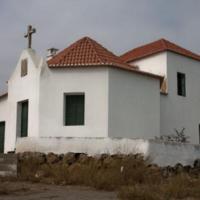
National Museum of Slavery
The Angolan National Museum of Slavery (or Museu Nacional da Escravatura in Portugese) was founded by the National Institute of Cultural Patrimony in 1997. Its main aim is to depict the history of slavery in Angola. The museum is situated in a chapel which once belonged to Álvaro de Carvalho Matoso, one of the largest Portugese slave-traders in the eighteenth century. It is also next door to Capela da Casa Grande, a seventeenth-century structure which was once used for baptising enslaved Africans before they were shipped to the Americas. The museum has a large collection of items that were utilised in the slave trade, as well as items relating to African culture pre- and post- transatlantic slave trade and a vast photography collection. Situated 15.5 miles outside the city of Luanda, the museum forms an extraordinary landmark along the "Slave's Route."
While the museum itself is realtively modest, it's aim is a big one; 'it is a testament and a reminder of the history of the Angolan people who lived in the day of slavery and it stands as a monument to those who suffered and were affected by slavery.' The narrative in the museum focusses predominantly on Portugal, the main European slave trader in the Angola region. It provides a contextual history of the Atlantic Slave Trade, as well as highlighting slavery in Africa before the involvement of Europeans.
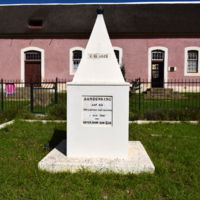
Elim Heritage Centre
Elim Heritage Centre was opened in 2009 in the Moravian mission village of Elim. Situated in the former mission store, it relies on funding from a grant by SAN Parks which permits a modest salary for its sole member of staff. Elim was established in 1824 and, in common with other mission stations in the area, saw an influx of newly freed people following the end of the post-abolition apprenticeship period in 1838. The centenary of the ending of the apprenticeship period in 1938 was marked in Elim by a monument situated across the road from the Moravian Mission Church. A feasibility study for an Elim offshoot of UNESCO’s Cape leg of its Slave Route project in the late 1990s revealed that many Elim residents were unaware about their slave heritage. Although the feasibility study did not amount to a longer-term UNESCO project, the undertaking did encourage interest in slave history in Elim. The 1938 monument was rededicated in 2004, and the Heritage Centre’s foundation can be traced to the feasibility study. As well as featuring as a community repository including donated trade and home objects, photographs, and clothing, its collections include a series of display panels created by the Slave Route feasibility study.
The Heritage Centre’s displays are modest and consist mainly of photographs pinned to display boards. There is little on slavery itself, although one primarily photographic panel shows a clear pride in the 1938 memorial and the way in which it has functioned as a form of remembering slavery over time in Elim. Reference is made to 1 December Emancipation Day as a way of reconnecting with ancestors. Another display details the genealogical origins of Elim, giving the names of early settlers among whom formerly enslaved people are clearly evident. The Slave Route display panels are not on open display. Indeed, it is the behind the scenes work of the curator where the Heritage Centre’s connections with slavery become more apparent. It holds substantial church records, and the curator assists with genealogical enquiries from around the world, including from people researching their slave ancestry.
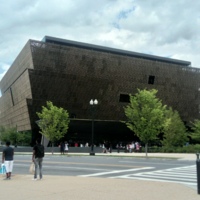
National Museum of African American History and Culture
The National Museum of African American History and Culture opened in September 2016, after more than a century of development. Designed to "tell the American story through the lens of African American history and culture," it forms the only national museum in the USA that is exclusively devoted to the documentation of African American history and culture. It stands on Washington's National Mall as the newest, nineteenth museum of the Smithsonian Institute. Established by an Act of Congress in 2003, the museum has had over one million visitors since its opening.
The displays in the museum are divided into two halves. There are three history galleries, charting key events in the history of America, with specific reference to the experience of the African American community. These galleries begin with displays about Africa prior to the slave trade, showcasing the rich culture and advanced nature of civilisations there. The displays then move on to enslavement, the Middle Passage and Plantation Life. In all of these displays, the experience of the enslaved people is central to the interpretation, and much use is made of archive material, providing quotations which bring the voices of the enslaved to the fore of the narrative.
The displays in the history galleries go on to interpret abolition, reconstruction, emancipation and Civil Rights. They end with the inauguration of Barack Obama in 2009. The displays make use of a wealth of collections, some 36,000 objects now belong to the museum. The key to the narrative throughout all of these displays is the central position of African Americans to the national history of America.
The other side of the museum consists of three 'community galleries.' Again these focus on the achievements of African Americans, through themes like sport, military, theatre, television, literature and art. Here, some of the museum's 'celebrity' artefacts, including Michael Jordan's NBA finals jersey and one of Jimi Hendrix's vests. This section of the museum also houses the 'Robert Frederick Smith Explore Your Family History Centre,’ where visitors can look at digitised archive material with expert guidance to explore their own family tree.
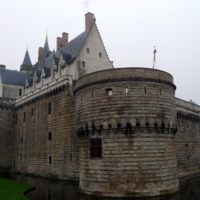
Musée d’histoire de Nantes
Musée d’histoire de Nantes (Nantes History Museum) was originally the residence of the Dukes of Brittany and the castle was restored in the 1990s. It opened to the public as a museum in February 2007. The museum is not wholly dedicated to looking at slavery, but explores the history of the castle and the city. However, it is acknowledged that the Atlantic slave trade is a key part of that history. The themes covered within the museum begin with the construction of the castle in the 13th century, and then follow the development of Nantes as part of Brittany through the ages until the 17th century. The museum also examines trade, the impact of the French Revolution, industrialisation, the two world wars and a contemporary look at Nantes as an ‘Atlantic City’. The museum added several rooms in 2016 that looked with greater detail at modern history. It has been designated a 'Monument Historique' by the French government. In addition to the historical artefacts housed in the museum, interactive and digital media is incorporated throughout as a part of the museum's aim to showcase the history of the city not only through objects and art work, but also contemporary technology.
Slavery is mainly addressed in the exhibition ‘Trade and Black Gold in the 18th Century’, where the displays address the role Nantes played as a key French port for vessels embarking on the Triangular Trade. Objects on display include maps, paintings and a collection of printed canvases produced in Nantes that would have formed a significant proportion of the cargo taken on the first leg of the trade voyage, from France to Africa. As well as examining France’s role in the logistical aspects of the trade, this exhibition also includes interpretation about Haiti. This interpretation has a dual focus, with Haiti as the destination for most of the ships originating in Nantes and the site of the most successful slave revolt in the western hemisphere.
Other exhibitions within the museum also look generally at the larger events in French history and how they changed Nantes’s relationship with slavery. Within the exhibitions on Nantes and the Revolution, the long process of abolition and then re-entrenchment of slavery under Napoleon are discussed in the interpretation. Until 1831 Nantes was still France’s largest slave trading port despite the activity being previously outlawed in 1816. Similar to the Memorial to the Abolition in Nantes, the Nantes History Museum intends to provide a reflection on local history both good and bad.
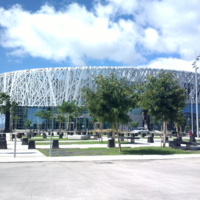
Memorial ACTe
On the former site of a sugar factory, Guadelopue's Memorial ACTe stands as a cultural institution that aims to preserve the memory of those who suffered during slavery, as well as to act as a space for discussion on the continuing repercussions. Part of UNESCO's Slave Route project, its main focus is on the challenges of bondage in the Guadeloupe islands. Memorial ACTe was opened in 2015 by then French President, Francois Hollande, and nineteen other heads of state.
The Memorial ACTe is a unique museum, both internally and externally, through its architectural design. It is also a centre for live arts and debates. It aims to provide interpretation through a variety of viewpoints and disciplines, using not only history but ethnology, social anthropology and history of art as well. The history of slavery and the slave trade are explored through a range of archival material, images and artefacts, with visual and audio installations too.
The permanent exhibition space examines the history of slavery from antiquity to the present day, using objects, reconstructions, visual and audio installations and digital interactives. The temporary exhibition space focusses on contemporary forms of artistic expression in relation to slavery around the world. In addition, there is a research centre where visitors can look into their genealogy, as well as a library and a conference hall.
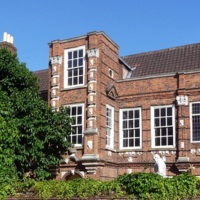
Wilberforce House Museum
Wilberforce House Museum is one of the world's oldest slavery museums. It opened in 1906 after the building, the house where leading abolitionist William Wilberforce was born, was bought by the Hull Corporation to preserve it for reasons of learning and of civic pride. Initially a local history museum, at the centre of Hull's historic High Street, the collections soon expanded through public donations and, unsurprisingly, these donations focussed heavily on items relating to Wilberforce. Today the museum and its collections are owned by Hull City Council and managed by Hull Culture and Leisure Limited. It forms part of Hull's 'Museums Quarter' alongside museums on transport, local social history and archaeology. In addition to the Wilberforce displays, the museum also features period room settings, silver, furniture and clocks, as well as a gallery exploring the history of the East Yorkshire Regiment.
The galleries at Wilberforce House Museum tell many different stories. An exploration of the history of the house welcomes visitors into the museum, followed by displays about William Wilberforce from his childhood, to his work and his family life. These galleries have examples of costume, books, domestic items and even the 1933 Madame Tussauds wax model of Wilberforce himself. Up the grand cantilever staircase, installed by the Wilberforce family in the 1760s, the displays continue. Here they look at the history of slavery and the origins of the British transatlantic slave trade. One gallery contains items that illustrate the richness of African culture prior to European involvement, dispelling the traditional myth that Africa was empty and uncivilised before the intervention of the Western world. Following that, the exhibition narrative goes on to look at the process of enslavement, the logistics of the trading system, the Middle Passage and slave auctions. Again, a wide range of collections are used to illustrate the informative panels. This is repeated in the displays about plantation life and resistance.
Of course no museum about William Wilberforce would be complete without an exhibition on antislavery and the abolition movement. This is extended with two galleries which look at the legacies of such a campaign in terms of modern slavery and human rights today. There are opportunities in these galleries for visitors to provide their comments and opinions, through several interactives, as well as engage with ideas as to how they can actively participate in today's campaign to end modern slavery.

Museum of London Docklands
The Museum of London Docklands houses the Port and River collections of the Museum of London. The aim of these museums is to showcase the growth and development of London, from the Roman era through to the present day. In a period of expansion for the Museum of London, the Museum of London Docklands was opened in 2003 in a Grade I listed warehouse on West India Quay, the historic trading heart of London.
Due to its location in a warehouse which would very likely have stored sugar, and other slave-produced items, the history of the transatlantic slave trade and its impact on London fits well within this space. ‘London, Sugar and Slavery’ was originally produced in 2007 as part of the bicentenary commemorations but has since become a permanent part of the museum. The displays have a local focus, supported through a wide range of objects, and consider the impact of the slave trade on London historically and today.
On entering the gallery visitors are met with a list of ships that traded slaves from the West India Quay- placing them right there in the story. Next there are discussions of the economics of slavery, and indications of how the money made from it changed the city of London forever. The exhibition also includes discussions of resistance, and abolition- centring the movement on the mass movement in the wider population with a case entitled ‘Abolition on the Streets.’ To bring the display up to date there is a discussion of representations of black people in popular culture, with objects including children’s books, film memorabilia, toys and prints, in line with a further piece on racism in London.
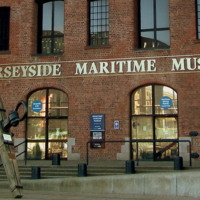
International Slavery Museum
The International Slavery Museum (ISM) is the first museum in the world to focus specifically on slavery, both historical and modern. Managed by National Musuems Liverpool, it opened to great acclaim in 2007 and has since welcomed over 3.5million visitors. Through its displays and wide-ranging events programme, the ISM aims to tackle ignorance and misunderstanding in today’s society by exploring the lasting impact of the transatlantic slave trade around the world. On entering the ISM, visitors immediately arrive in a space designed to provoke thoughts and discussion- the walls are etched with powerful quotations from historical figures and contemporary activists, many from the African diaspora. There is a display of West African culture, designed to showcase the breadth and depth of African civilisation before the devastation caused by the transatlantic slave trade, which includes examples of textiles, musical instruments and other ethnographic material. The display then goes on to look at the trade itself; the logistics, the processes and who benefitted on one hand, whilst also exploring the experience of the enslaved through multisensory interpretive techniques, including an emotive film of what the Middle Passage may have been like. All of these displays are supported by the rich, local archival collections, drawing on Liverpool’s own history as a prosperous, slave-trading port. Moving forward along a chronological timeline, the exhibition then covers abolition, significantly beginning with the acts of resistance from the enslaved themselves, through to organised abolition movements and then discussing the continued fight for freedom through the post-emancipation then civil rights era, right into the twenty-first century. The lasting legacies of the trade are thoroughly examined, from racism and the under-development of African countries, to the spread of African culture and diverse nature of Liverpool’s communities. A unique feature of the ISM is its ‘Campaign Zone’, opened in 2010, which houses temporary exhibitions just off the main gallery space. These are frequently run in conjunction with campaign organisations and usually focus on aspects of modern slavery, highlighting to visitors that it is very much still a live issue and not one that has been relegated to history. Recent exhibitions in this space have included 'Broken Lives' organised with the Daalit Freedom Network and 'Afro Supa Hero' with artist Jon Daniels.